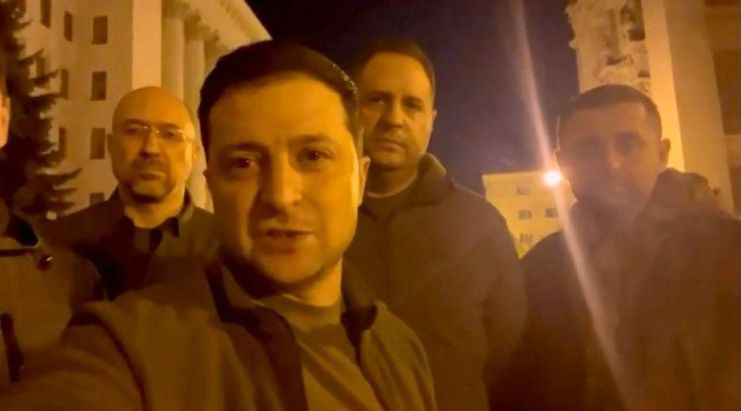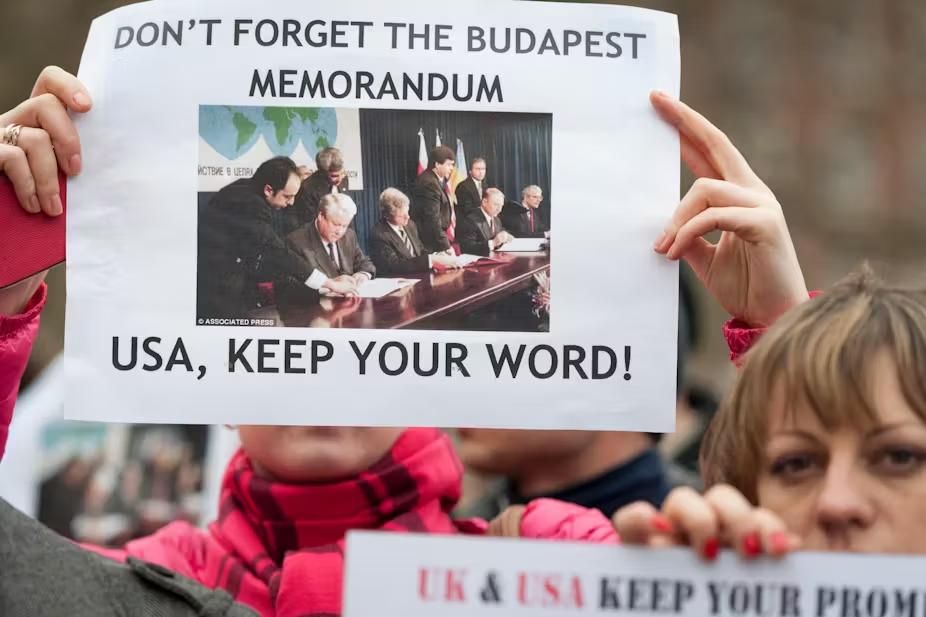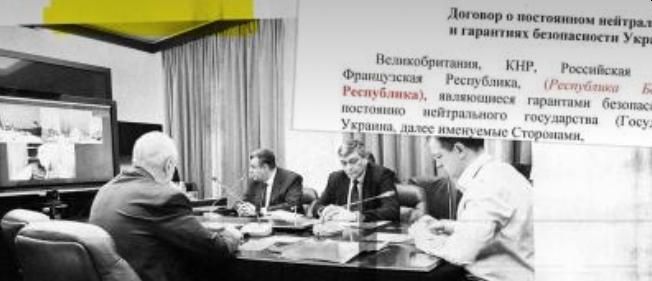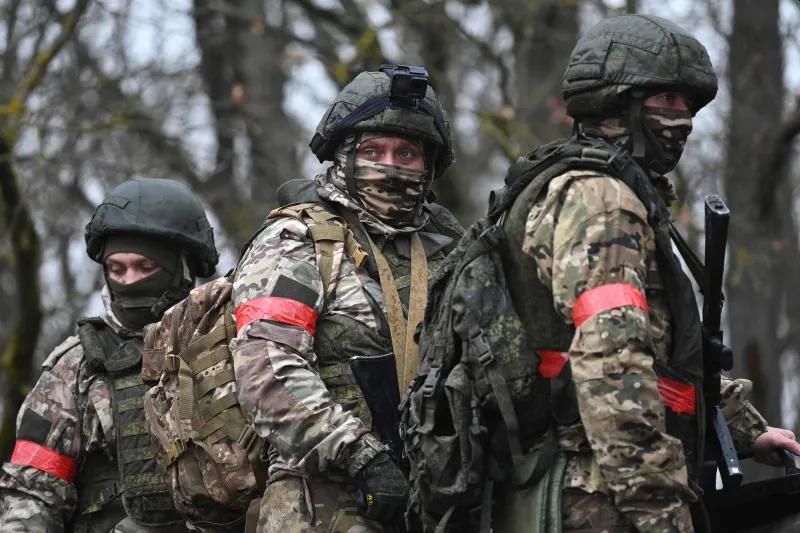By Eric Vandenbroeck and co-workers
A Pathway to Peace in Ukraine Trump
Needs a Realistic Game Plan
The lead picture on the
website is from when Zelensky was threatened by Russia that his country would be
invaded and Russia would come for him, the US offered free passage for Zelensky
who refused and said I stay here; in fact, he is still here today.

Between the late
eighteenth century and 1917, people who came to identify themselves as
Ukrainians lived in both the Russian and Austro-Hungarian empires. This split
historical experience is the basis for Putin’s claim that part of Ukraine is in
Eastern Europe while most of it “was given” to Russia. It also explains why the
formation of a unified Ukrainian national identity has been such a
challenge. In 1994 the U.S., the U.K., and Russia guaranteed
Ukraine's security in an agreement known as the Budapest
Memorandum whereby Putin's petty excuses to violate its clear
commitments are craven violations of international law and norms.

For those seeking to
end Russia’s devastating war in Ukraine, the election of Donald Trump presents
a crucial opportunity. In direct contrast to U.S. President Joe Biden, whose
administration has held to a policy of unwavering support for Ukraine without
pushing for a defined endgame to the war, Trump has focused almost exclusively
on that endgame. He has long made clear his intention to bring the two sides to
the negotiating table soon after he takes office and maybe even before that.
Within weeks of his election victory, he named a retired general and former
senior official, Keith Kellogg, as special envoy for Russia-Ukraine,
underscoring the priority he and his administration will place on winding down
the war.
This coming radical
shift in the U.S. approach to the war could revive negotiations that have been
effectively dormant since April 2022. Back then, in the first weeks of the war,
Russia and Ukraine conducted several rounds of talks in person and online
aimed at ending the conflict; although a framework for peace called the
Istanbul Communiqué was drawn up, an agreement was never finalized. In the
run-up to and since Trump’s election, however, there have been signs that both
Kyiv and Moscow might be ready to return to the table. This is particularly
true of the Ukrainians, who have been losing ground—as well as people and
energy generation capacity—for two years and need urgent relief before their
manpower situation becomes critical. Russia also faces some challenges: it is
taking more ground by the day but at an extremely high price, and the Kremlin
wants to lock in those gains without having to incur enormous costs
indefinitely.

Although the
president-elect has not yet articulated a clear plan for ending the war, he has
given hints of the approach he might take. Specifically, Trump often points to
the horrible human costs of the war and indicates a desire to put an end to the
fighting as soon as possible. But pursuing a cease-fire agreement that does not
address the underlying drivers of the conflict is unlikely to work. Indeed, a
deal that just ends the fighting would likely be unacceptable to both Kyiv and
Moscow.
To gain traction, any
U.S. approach to talks must take account of the broader drivers of the conflict
that are in play on both sides and how they can plausibly be addressed. The
administration will need to both formulate a comprehensive endgame for the war
that addresses these core issues and craft a diplomatic strategy for getting
there. That means not only setting out a road map for a durable cease-fire but
also identifying ways to assure Ukrainian security, providing incentives to
both sides and laying out a strategy for stabilizing Russia’s relations with
the West.
Tell Them How it Ends
A crucial
prerequisite for a successful U.S. approach to negotiations is a defined endgame.
The Biden administration has made it a matter of policy not to define a U.S.
objective for the war in Ukraine but rather to support Ukraine for “as long as
it takes” and to defer to Kyiv on the details of the desired outcome. This
pointed refusal to have a defined U.S. goal is not the norm for U.S. foreign
policy. Although it can be awkward for the United States to state a desired
outcome for a conflict in which it is not a direct participant, Washington has
often done so when the stakes for U.S. interests were high and it had leverage,
as, for example, in the 1995 Dayton peace accords that ended the Balkan wars or
in President George W. Bush’s “road map” to a resolution of the
Israeli-Palestinian conflict. Indeed, Biden himself specified the U.S. vision
of an endgame for the other ongoing conflict of major geopolitical
significance, the war in Gaza.
In this context,
Biden’s refusal to articulate a U.S. plan for ending the war in Ukraine is a
glaring omission. For much of the past year, the president’s silence on the
issue has sparked bipartisan ire in Congress, which demanded such a strategy
when it approved the administration’s $60 billion supplemental request for
Ukraine in April. Moreover, in the absence of a U.S. strategy, other powers,
including China and Brazil, have dominated the international conversation about
ending the war: Beijing alone has penned three different peace plans. That
Trump has so swiftly redirected that conversation away from the Chinese peace
plans—and even the Ukrainian plan—underscores the leverage the United States
has always had to shape the outcome.
As of now, Trump has said
he wants the fighting to end, but he has not laid out a plan to get there. Any
such plan should include four key features: a well-designed cease-fire
agreement, a credible guarantee of Ukraine’s postwar security, a way to provide
accountability for Russia’s aggression, and measures to stabilize
Russian-Western relations. The question of which side controls what territory
is unlikely to be decided at the negotiating table; the line of contact,
perhaps with some small swaps and adjustments, will remain where it is when the
guns fall silent. Moreover, territorial control, while extremely important to
both sides, is ultimately not as core a concern as these broader political
issues. And recognition of Russian annexations is rightly considered a
nonstarter for both Ukraine and its Western backers.
Russian soldiers undergoing training in Krasnodar,
Russia, December 2024

Arm the Porcupine
To avoid renewed
fighting, a U.S. peace initiative must include measures to deter Russia, assure
Ukraine, and provide incentives to both sides to maintain the cease-fire.
Security guarantees for Ukraine that are directly tied to the cessation of
hostilities can advance all three of these objectives. If there are significant
costs tied to a future Russian attack—whether because it will trigger
third-party intervention or retaliation from a Ukraine armed with an enhanced
deterrent—Moscow will be less likely to undertake one. And if Kyiv is convinced
that its security is guaranteed, it will be able to focus on economic recovery
and democracy rather than on becoming a garrison state.
Kyiv is seeking
security guarantees in the form of accession to NATO. But neither the Biden
administration nor the incoming Trump administration appear willing to offer
that possibility either during the war or in its immediate aftermath. Moreover,
preventing Ukraine from joining NATO has been a Russian policy objective for
decades, and it was among Russian President Vladimir Putin’s core motives for
attacking Ukraine in 2022. Even if membership in the alliance were a viable
option, it is a clumsy policy instrument for ending a war. Accession would
require the approval of 32 parliaments and thus take months at best, and it
would be contingent on Ukraine implementing many reforms that have nothing to
do with conflict resolution.
In fact, there are
other, potentially more effective ways to provide a security guarantee to
Ukraine in the context of a negotiated end to the war. On multiple occasions
since World War II, the United States has made bilateral security commitments
to allies and partners in comparable post conflict situations. Two months after
the end of the Korean War, the United States signed a bilateral mutual security
treaty with South Korea in which Washington committed to come to Seoul’s aid if
it were attacked. After the 1973 Arab-Israeli war ended, the United States
reached an agreement with Israel in which it committed to “remedial action” if
Egypt violated the cease-fire or if there were “threats to Israel’s security or
sovereignty by a world power.” These approaches, which helped produce enduring
periods of relative stability and peace, could provide models for what might be
offered to Ukraine in a future negotiation.
Another kind of
security guarantee could take the form of Ukraine’s eventual EU membership.
Article 42.7 of the Treaty on European Union, known as the EU’s mutual
assistance clause, states that if a “Member State is the victim of armed
aggression on its territory, the other Member States shall have towards it an
obligation of aid and assistance by all the means in their power.” This
language is arguably more binding even than NATO’s common defense pledge,
Article 5, and Russia already agreed not to stand in the way of Ukraine’s EU
membership during the 2022 talks.
Whether or not
Ukraine gets binding external commitments to its security, it will need an
independent deterrent in the form of strong armed forces. The Biden
administration and numerous NATO allies have already laid the groundwork for
providing Ukraine the necessary training, arms transfers, and intelligence
cooperation to create this deterrent in the bilateral security agreements
signed earlier this year. But Ukraine’s partners need to consider how best to
arm Ukraine to ensure a sustainable peace. Enabling a force focused on combined
arms offense and long-range strike capabilities, for example, could make a
second Russian invasion more, not less, likely by exacerbating the Kremlin’s
threat perceptions.
Instead, allies
should enable Ukraine to adopt a “porcupine model” of defense through their
security cooperation. This would entail helping Ukraine develop a force that is
optimized for defending the territory that Kyiv controls when the fighting
ends, instead of providing training aimed at improving the ability to retake
Russian-held territory. There is, of course, no clear-cut distinction between
offensive and defensive capabilities and no off-the-shelf guide for what a
porcupine model for Ukraine should look like. But aid focused on helping Kyiv
to hold territory should help enable a future Ukrainian force to be more
effective at deterring a future Russian attack.

Engage Russia
It will take more
than just commands from Ukrainian President Volodymyr Zelensky and Putin to
durably end the fighting on the frontline. For one thing, the size of the
front, by the standards of contemporary global conflicts, is extraordinary and
presents challenges of its own. Taking into account the undisputed areas along
Ukraine’s borders with Belarus and Russia, as well as the line of contact in
Ukraine, the front extends nearly 1,200 miles.
Policing such a line
would require tens of thousands of peacekeepers, an impossibly large
number—even if Russia and Ukraine agreed to allow such a force, which is highly
unlikely. Nonetheless, unmanned systems and sensors could be leveraged to
establish an effective monitoring system along the cease-fire lines. Such a
system would likely require third-party oversight to assess the information
coming in and to arbitrate disputes. Accountability mechanisms would have to be
built in to ensure violations come at a cost. And a demilitarized zone with
clear limits for deployments on both sides should be carefully designed to
avoid the pitfalls of the Minsk agreements—the deals signed in 2014 and 2015
intended to end that earlier phase of Russia’s war—which did not contain a
mutually agreed cease-fire line or clear disengagement commitments.
Another crucial issue
will be assuring that the Kremlin’s aggression entails enduring costs to deter
Russia or any other state from invading neighbors. Although Putin will
inevitably claim victory when the fighting stops, the rest of the world should
not come away with the impression that Russia has paid no cost for its
aggression. The West can impose those costs by maintaining some sanctions and
export controls as measures in place for the long term—or until Russia fully
withdraws from Ukraine. Additionally, as part of the settlement, the roughly
$300 billion in Russian state assets that are already frozen in Western
countries could go to the reconstruction of Ukraine—with Russia’s explicit
agreement. The Kremlin in all likelihood recognizes that it will never see
those funds again, so such a deal is not implausible. Unless Moscow legally
consents that the funds be used for that purpose, key European states will
continue to object to spending them for fear of setting a dangerous precedent.
Moscow is likely to demand in return that Ukraine relinquish further monetary
claims on Russia for damages done during the war.
Russia will also need
some positive incentives to comply with a settlement. Assurances that Ukraine
will remain nonaligned, that foreign forces and infrastructure will not be
deployed in Ukraine, and that mutual understandings can be reached on the limits
of Western military aid, could be put on the table—and such assurances need not
necessarily be incompatible with Western security guarantees for Ukraine. These
would be similar to what the parties themselves imagined in the 2022 Istanbul
Communiqué. Incentives could also encompass partial sanctions relief, with
snap-back clauses to reimpose them if Russia violates the terms of the deal.
Further, Russia is unlikely to agree to end the fighting without talks on
NATO-Russian issues that go beyond Ukraine, such as the conventional force
balance and long-range strike capabilities on the continent. Agreeing to a
consultation process to address these issues in parallel to talks on the war
itself could be part of the arrangements to end the war. Establishing
such a process is no gift to Russia; it would serve Western interests as well
since any durable settlement will require managing broader Russian-Western
tensions.
Riding a bicycle near a front line in Donetsk,
Ukraine, December 2024

Communication is Key
In addition to
identifying the main elements of a settlement, the United States needs a plan
for getting there. The first step is for Washington to begin a dialogue with
Kyiv and U.S. allies about the endgame. Surprisingly little time has been spent
on this issue since the war began. Indeed, to this day, many senior U.S. and
European officials see it as a secondary priority; in December, the new
secretary-general of NATO, Mark Rutte, said, “We need to have these debates,
but for the immediate future, the most important thing is to get your military
aid into Ukraine.”
That approach needs
to change. A negotiation is coming, and U.S. and European officials need to be
ready. Preparing for the talks and building consensus on the overall approach
will take time—and should start immediately. Input from Ukraine will be essential.
Without advice from the United States and its allies, Kyiv has produced
unrealistic ideas on ending the war—such as Zelensky’s victory plan announced
this fall. The Ukrainian president and his team would benefit from regular
engagement with their Western counterparts on diplomatic strategy to avoid this
kind of dissonance.
The next step is
opening channels of communication with Russia. There has been no regular
dialogue between Moscow and key Western capitals since the full-scale invasion
began. For negotiations to have any chance of success, exchanges of views, even
without any expectation of reaching agreement, should become the rule and not,
as they are now, the exception. In this regard, Trump’s appointment of Kellogg
as special envoy on the war presents a significant opportunity, since it can be
used to cajole Putin to appoint a Russian counterpart. That would ease
engagement with Moscow significantly; at the moment, no one in the Kremlin
appears to have the authority to negotiate on these issues.
Finally, in advance
of beginning actual talks, the United States should push forward de-escalation
measures. Two such efforts are already on the table: a Turkish-brokered
agreement to avoid strikes on civilian shipping in the Black Sea and a
Qatari-negotiated deal to avoid strikes on energy infrastructure. The text of
both arrangements was largely finalized, but neither got over the finish line.
A push from Washington could help. Additional such measures could include
commitments to not strike beyond a certain distance from the line of contact;
all-for-all prisoner-of-war exchanges, as opposed to the current practice of
exchanging only equal and limited numbers of prisoners; and a pledge to not
engage in further raids across the areas of the international border that both
sides still recognize as such. (That last measure would rule out another Kursk
offensive but also any Russian effort to create a buffer zone in the Sumy
region of Ukraine, which borders Kursk.)
If some of these steps
begin to bear fruit, consultations could begin on multiple tracks. In addition
to bilateral contacts between Kyiv and Moscow, a contact group could be
established involving Ukraine, Russia, key Western powers, and perhaps China.
Separately, dialogues on U.S.-Russian and NATO-Russian issues could commence in
parallel.
A Year, Not a Day
As Trump and Kellogg
prepare to launch negotiations, there are several important pitfalls that
should be avoided. First, it will be crucial to manage expectations—those of
both the public and the governments involved. Trump’s promise of a 24-hour
negotiation was likely aspirational, but it seems clear his team wants to move
quickly. Yet as was true in many previous conflict talks, it is more likely
than not that initial attempts at negotiations will fail; the path will be long
and require great expenditures of time and high-level attention from the United
States and its allies. The extent of the enmity between Russia and Ukraine—and
between Russia and the West—and the dearth of communication among the parties
over the past few years will make talks very difficult to get off the ground
and a long slog once they do.
It would be
surprising if diplomatic efforts to end the war succeed in less than a year—if
they succeed at all. Consider that it took two years and more than 500 meetings
for the parties to the Korean armistice to come to agreement. Beyond stopping
the fighting in Ukraine, the even larger task of stabilizing Russian-Western
relations will likely require an open-ended process rather than a single agreed
document. Another risk of pushing for a quick deal is that it may create the
impression that the United States values getting a deal done more than getting
a good one. Washington would not want to create expectations in Moscow that the
United States is uninterested in the details and thus willing to make
significant concessions in the interest of a quick resolution.
Another pitfall would
be the use of ultimatums to force the sides to accept a deal. Some in Trump’s
orbit have advocated wielding U.S. military aid to Ukraine as a cudgel against
whichever party proves intransigent in the talks: either by threatening to ramp
up assistance to Kyiv to put the screws on Russia or to cut it off if Ukraine
refuses to make the necessary compromises. Either step could backfire. It is
not in the U.S. interest to cut off aid to Ukraine completely under almost any
circumstance, because that could enable a Russian takeover of the country.
Given how much aid the United States has already provided to Ukraine, there is
not much room for Washington to expand the flow of arms quantitatively, and
further qualitative increases would entail unacceptable escalation risks. In
any case, such threats are unlikely to prove effective: U.S. leverage with
Russia and Ukraine is significant, but not so much so as to force either of
them to take what they see as a bad deal since both see the issues at stake as
existential or near existential.
Third, Trump and
Kellogg should avoid making this a bilateral U.S.-Russian negotiation. Putting
aside the immorality and ugly historical resonances of excluding Kyiv from
deciding its own fate, it is necessary to involve the Ukrainian side on purely
pragmatic grounds: Ukraine can scuttle any deal that it finds unacceptable.
Additionally, there are compelling practical reasons to keep the Europeans and
other U.S. allies such as Japan involved: the EU accession process is key to
Ukraine’s future stability; allies’ economic resources will be necessary to
support reconstruction; and having a unified U.S.-European position will
prevent either Russia or Ukraine from playing one side off the other.
Although the coming
to power of a U.S. president who pledges to quickly end the war raises the
possibility of a breakthrough, it also poses major risks. These will be
high-stakes negotiations, mostly between two embittered belligerents in a war
that has killed tens of thousands—and maybe hundreds of thousands—on both
sides. If Trump’s efforts fail, the dynamic of the conflict will not simply
revert to a stable status quo ante: the war is intensifying, and it is also
becoming more internationalized. With a well-defined vision of the endgame and
a game plan to get there, the incoming administration could help bring an end
to this horror and the growing risks it poses to the broader world.
For updates click hompage here